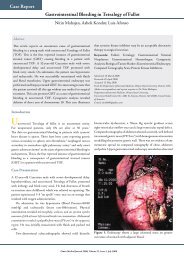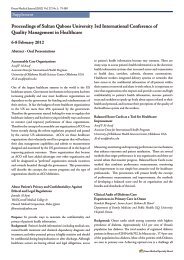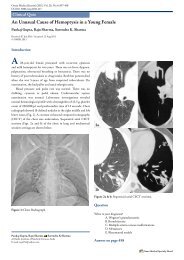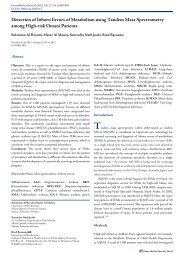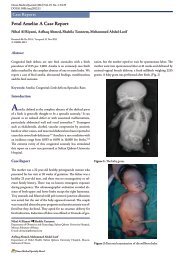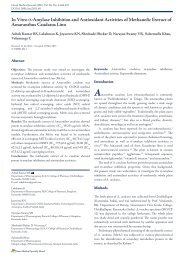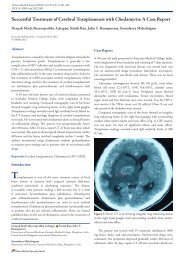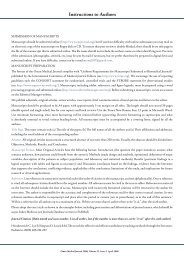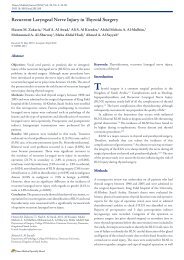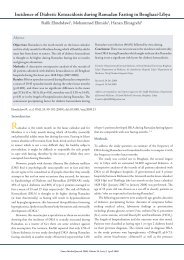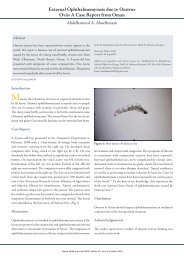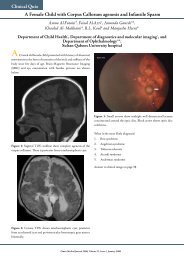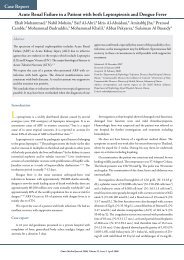Prepubertal Hypertransfusion in Thalassemia Intermedia: A ... - OMJ
Prepubertal Hypertransfusion in Thalassemia Intermedia: A ... - OMJ
Prepubertal Hypertransfusion in Thalassemia Intermedia: A ... - OMJ
Create successful ePaper yourself
Turn your PDF publications into a flip-book with our unique Google optimized e-Paper software.
Oman Medical Journal (2012) Vol. 27, No. 6<br />
DOI 10. 5001/omj.2012.125<br />
<strong>Prepubertal</strong> <strong>Hypertransfusion</strong> <strong>in</strong> <strong>Thalassemia</strong> <strong>Intermedia</strong>: A Case Report<br />
of Susta<strong>in</strong>ed Positive Effects on Growth, Splenic Function and Endocr<strong>in</strong>e<br />
Parameters<br />
Surekha Tony, Shah<strong>in</strong>a Daar, Mathew Zachariah, Yasser Wali<br />
Received: 12 Aug 2012 / Accepted: 17 Oct 2012<br />
© OMSB, 2012<br />
Abstract<br />
We report a known case of thalassemia <strong>in</strong>termedia (Hb Dhofar)<br />
who <strong>in</strong> spite of mild thalassemic facies, atta<strong>in</strong>ed his normal genetic<br />
height, pubertal maturity and improved self-image with m<strong>in</strong>imal<br />
splenomegaly through a hypertransfusion/chelation regimen<br />
that was started just before puberty and ma<strong>in</strong>ta<strong>in</strong>ed for 5 years.<br />
As there are no clear guidel<strong>in</strong>es <strong>in</strong> the management of patients<br />
with thalassemia <strong>in</strong>termedia, the option of hypertransfusion/<br />
chelation dur<strong>in</strong>g the pubertal growth spurt may alleviate some of<br />
the complications associated with thalassemia <strong>in</strong>termedia.<br />
Keywords: <strong>Thalassemia</strong> <strong>Intermedia</strong>; Prepuberty;<br />
<strong>Hypertransfusion</strong>.<br />
Introduction<br />
<strong>Thalassemia</strong> <strong>in</strong>termedia (TI) is a cl<strong>in</strong>ical designation often<br />
used to characterize <strong>in</strong>dividuals who are homozygous for betathalassemia<br />
genes but ma<strong>in</strong>ta<strong>in</strong> hemoglob<strong>in</strong> levels of 6-9 g/<br />
dl without regular transfusions. The term TI has been used to<br />
describe the cl<strong>in</strong>ical and hematologic f<strong>in</strong>d<strong>in</strong>gs <strong>in</strong> patients whose<br />
disease is not as severe as that which characterizes homozygous<br />
beta-thalassemia, but is more severe than the heterozygous<br />
carrier. 1 Hb Dhofar is a variant hemoglob<strong>in</strong> (beta[29 (GGC-<br />
GGT) gly-gly], beta[58 (CCT-CGT) pro-arg]) associated with<br />
a thalassemic phenotype and unique to the Sultanate of Oman.<br />
Cl<strong>in</strong>ical and hematological data suggest that this mutation behaves<br />
like a moderately severe beta (+) thalassemia allele result<strong>in</strong>g <strong>in</strong> a<br />
TI phenotype. 2 The available options <strong>in</strong> the management of TI<br />
patients <strong>in</strong>clude splenectomy, transfusion therapy, iron chelation<br />
therapy and the use of cytotoxic drugs such as hydroxyurea to<br />
<strong>in</strong>crease the Hb F level. 3 We report of a 19 year old Omani male<br />
with known Hb Dhofar, who was <strong>in</strong>itiated on hypertransfusion<br />
regimen at the age of 11 years (prepubertal) for 5 years.<br />
Surekha Tony, Mathew Zachariah, Yasser Wali<br />
Department of Child Health, Sultan Qaboos University Hospital, Muscat,<br />
Sultanate of Oman.<br />
E-mail: yawali@squ.edu.om<br />
Shah<strong>in</strong>a Daar<br />
Department of Hematology, Sultan Qaboos University Hospital, Muscat,<br />
Sultanate of Oman.<br />
Case Report<br />
The patient was a 19 year old boy, diagnosed with Hb Dhofar<br />
at the age of 6 years. We offer most of our moderately severe TI<br />
patients the option of hypertransfusion/chelation early <strong>in</strong> life<br />
(when they present at 5-6 years) and it is acceptable <strong>in</strong> most of<br />
the cases. In our patient, the family refused this option for some<br />
cultural beliefs and fear of risks of chronic transfusion. He was<br />
put on hydroxyurea 15 mg/kg/day for three months. The drug was<br />
stopped on parent’s request for fear of cytotoxic agent and results<br />
of XMN1 polymorphism was negative as well. He was started<br />
on folic acid and regular follow-up of his cl<strong>in</strong>ical condition. He<br />
ma<strong>in</strong>ta<strong>in</strong>ed a steady state Hb of 9 g/dl, however at the age of 11<br />
years, his Hb started to drop to 7-8 g/dl (hypersplenism) and<br />
his growth parameters were far below the 3 rd centile. His bone<br />
densitometry was very low with evidence of osteoporosis (Z-score:<br />
-2.5).<br />
He was started on a hypertransfusion regimen for 5 years<br />
(11-16 years of age), aim<strong>in</strong>g to improve his growth and reverse<br />
the other complications he suffered. The child was ma<strong>in</strong>ta<strong>in</strong>ed on<br />
deferiprone 75 mg/kg/day throughout his transfusion years and<br />
thereafter. The patient atta<strong>in</strong>ed normal puberty with all secondary<br />
sexual characteristics, and achieved his genetic height (75 th centile,<br />
Fig. 1). His bone densitometry did not show much improvement<br />
(Z-score: -2.8). His spleen size regressed to 2 cm below the left<br />
costal marg<strong>in</strong> with no evidence of hypersplenism. Transfusion<br />
was stopped after he achieved his genetic height and is currently<br />
on follow-up for 3 years with no further transfusions, and is<br />
ma<strong>in</strong>ta<strong>in</strong><strong>in</strong>g steady hemoglob<strong>in</strong> state of 9.5 g/dl. (Table 1)<br />
The follow<strong>in</strong>g tests were used for the diagnosis and followup<br />
of the patient: Genetic study for Hb Dhofar. DNA was<br />
extracted from blood, the <strong>in</strong>terest region of beta glob<strong>in</strong> gene was<br />
amplified by PCR. The product was visualized on a 2% agarose<br />
gel electrophoresis followed by purification with ExoSap (USB,<br />
Cleveland, OH, USA). Purified PCR products were sequenced<br />
on the ABI 3100 automated Sequence Analyzer (Applied<br />
Biosystems Inc) us<strong>in</strong>g the BigDye Term<strong>in</strong>ator Version 3.1 Cycle<br />
Sequenc<strong>in</strong>g Ready Reaction Kit (Applied Biosystems Inc). Then<br />
XMN1 polymorphism was done by RFLP, and 10μl aliquots of<br />
the amplified DNA is digested with 2-5 units of XmnI restriction<br />
enzyme and its reaction buffer <strong>in</strong> a 20μl reaction volume. The<br />
mixture was <strong>in</strong>cubated at 37°C for overnight. The digested DNA<br />
was applied onto a 2% agarose gel and electrophoresis was carried<br />
out at 100V for 45 m<strong>in</strong>utes. The band pattern was visualized <strong>in</strong> a<br />
Oman Medical Specialty Board
Oman Medical Journal (2012) Vol. 27, No. 6<br />
gel documentation system<br />
Figure 1: Radiology Bone densitometry and MRI T2* heart and<br />
liver.<br />
Table 1: Patient characteristics.<br />
Characteristics <strong>Prepubertal</strong> Postpubertal<br />
Hb (Mean g/dl) 7.4 9.5<br />
Spleen (cms below left costal 4 2<br />
marg<strong>in</strong>)<br />
Height (cms) 122 (11 years) 167 (16 years)<br />
178 (19 years)<br />
Weight (centile)
Oman Medical Journal (2012) Vol. 27, No. 6<br />
References<br />
1. Pearson H A. The Evaluation of <strong>Thalassemia</strong> <strong>Intermedia</strong>. The Genetic<br />
Resource: Special Issue, 1997; 11(2).<br />
2. Daar S, Gravell D, Husse<strong>in</strong> HM, Pathare AV, Wali Y, Krishnamoorthy R.<br />
Haematological and cl<strong>in</strong>ical features of beta-thalassaemia associated with<br />
Hb Dhofar. Eur J Haematol 2008 Jan;80(1):67-70.<br />
3. Karimi M, Haghpanah S, Farhadi A, Yavarian M. Genotype-phenotype<br />
relationship of patients with -thalassemia tak<strong>in</strong>g hydroxyurea: a 13-<br />
year experience <strong>in</strong> Iran. Int J Hematol 2012 Jan;95(1):51-56.<br />
4. Taher A, Musallam KM, Karimi M, El-Beshlawy A, Belhoul K, Daar S, et<br />
al. Overview of practices <strong>in</strong> <strong>Thalassemia</strong> <strong>Intermedia</strong> management aim<strong>in</strong>g for<br />
lower<strong>in</strong>g complication rates across a region of endemicity: the optimal care<br />
study. Blood 2010;115(10):1886-1892.<br />
5. Aessopos A, Farmakis D, Deftereos S, Tsironi M, Tassiopoulos S, Moyssakis<br />
I, et al. <strong>Thalassemia</strong> heart disease: a comparative evaluation of thalassemia<br />
major and thalassemia <strong>in</strong>termedia. Chest 2005;127(5):1523-1530.<br />
6. Isma’eel H, Chafic AH, Rassi FE, Inati A, Koussa S, Daher R, et al. Relation<br />
between iron-overload <strong>in</strong>dices, cardiac echo-Doppler and biochemical<br />
markers <strong>in</strong> thalassemia <strong>in</strong>termedia. Am J Cardiol 2008;102(3):363-367.<br />
7. Borgna-Pignatti C, Marsella M, Zanforl<strong>in</strong> N. The natural history of<br />
thalassemia <strong>in</strong>termedia. Ann N Y Acad Sci 2010 Aug;1202:214-220.<br />
8. Taher AT, Musallam KM, Cappell<strong>in</strong>i MD, Weatherall DJ. Optimal<br />
management of β thalassaemia <strong>in</strong>termedia. Br J Haematol 2011<br />
Mar;152(5):512-523.<br />
9. Taher A, Isma’eel H, Mehio G, et al. Prevalence of thromboembolic events<br />
among 8,860 patients with thalassaemia major and <strong>in</strong>termedia <strong>in</strong> the<br />
Mediterranean area and Iran. Thromb Haemost 2006;96(4):488-491.<br />
10. Cappell<strong>in</strong>i MD, Robbiolo L, Bottasso BM, Coppola R, Fiorelli AP, Mannucci<br />
AP. Venous thromboembolism and hypercoagulability <strong>in</strong> splenectomized<br />
patients with thalassaemia <strong>in</strong>termedia. Br J Haematol 2000;111(2):467-473.<br />
11. Taher A, Isma’eel H, Cappell<strong>in</strong>i MD. <strong>Thalassemia</strong> <strong>in</strong>termedia: revisited.<br />
Blood Cells Mol Dis 2006 Jul-Aug;37(1):12-20.<br />
12. Olivieri NF. The beta-thalassemias. N Engl J Med 1999;341:99-109.<br />
Oman Medical Specialty Board



